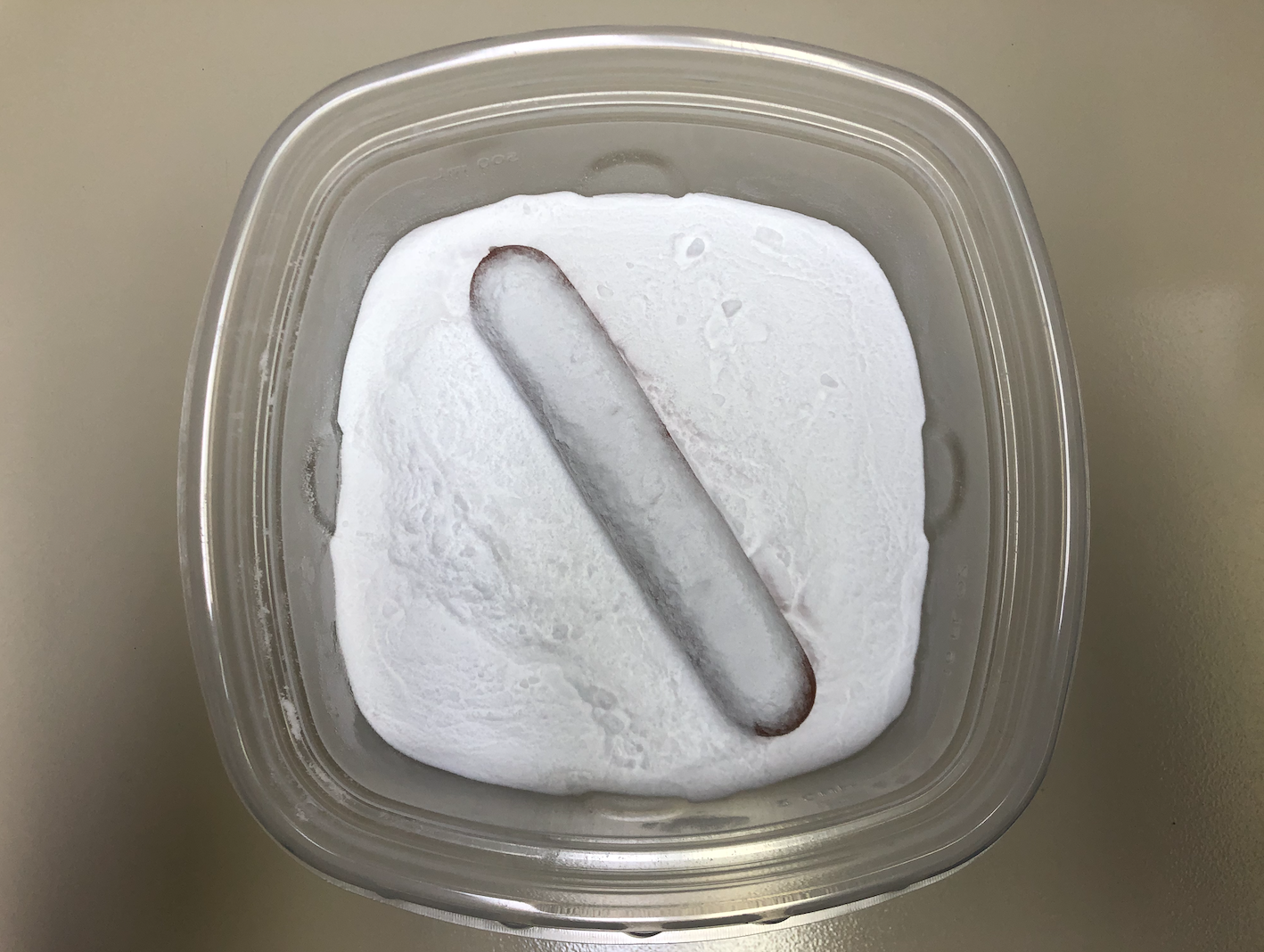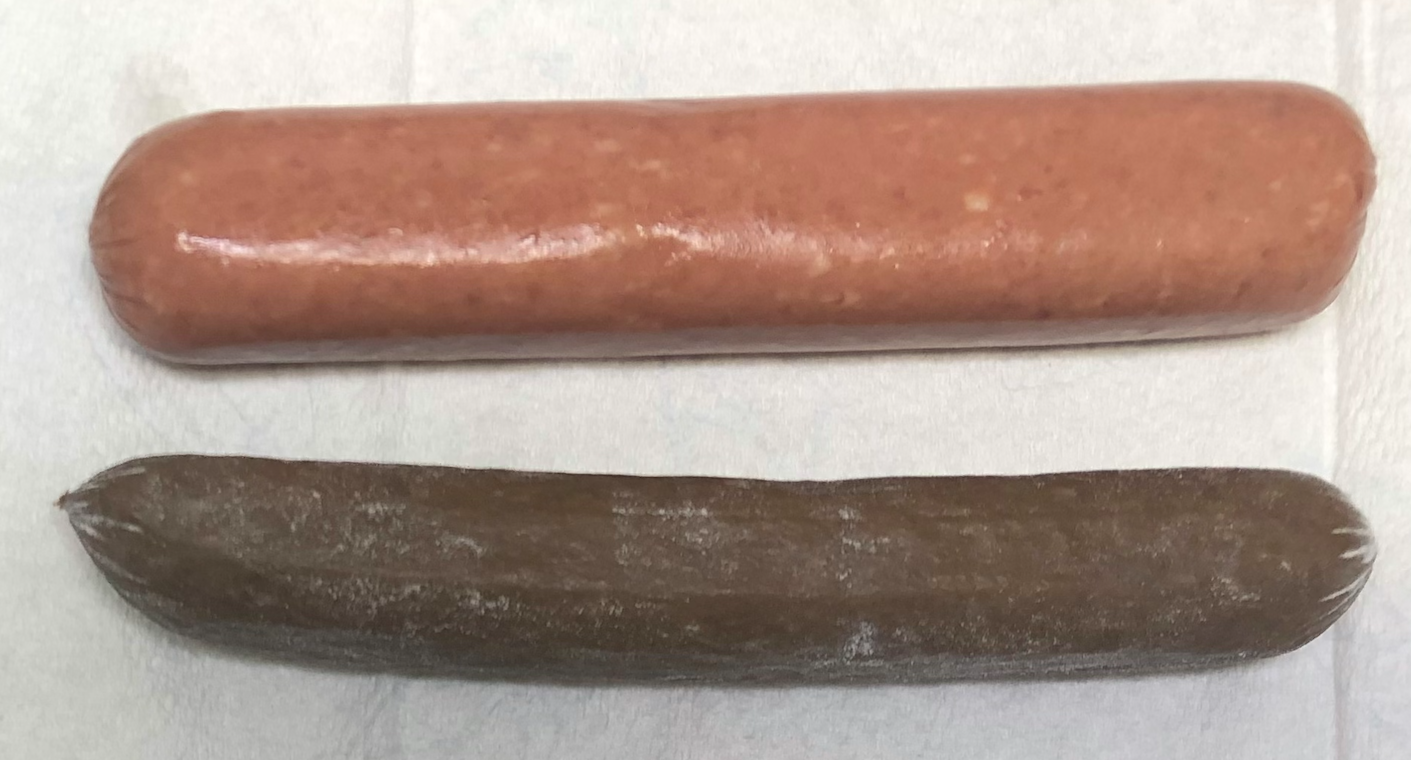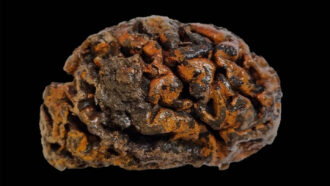Minding your mummies: The science of mummification
Learn about the rituals and science of mummification by mummifying a hot dog

Mimic ancient Egyptians' embalming practices by mummifying a hot dog at home with baking soda.
Steve McCracken
Objective: To study the science of mummification by mummifying a hot dog using baking soda
Areas of science: Human Biology & Health
Difficulty: Easy intermediate
Time required: 2 to 4 weeks
Prerequisites: None
Material availability: Readily available
Cost: Very low (under $20)
Safety: The result of this science project will be a mummified hot dog. Do not eat the mummified hot dog, as you could get sick.
Credits: Michelle Maranowski, PhD, Science Buddies; This science fair project is based upon an experiment found in the following book: Exploratorium staff, Macaulay, E., and Murphy, P. Exploratopia. New York: Little, Brown and Company, 2006, p. 97.
Most people associate ancient Egypt with the pharaohs, the Great Pyramids of Giza, and mummies. But what is the connection between these three things and what is a mummy?
A mummy, like the one shown in Figure 1 below, is a corpse whose skin and flesh have been preserved by chemicals or by exposure to the elements of weather. The ancient Egyptians believed that preserving the body was important because without the body, the previous owner’s “ka,” or life force, would always be hungry. It was important for a person’s ka to survive so that he or she could enjoy the afterlife, or life after death. The ancient Egyptians started mummifying remains about 3500 B.C., although older purposefully mummified remains have been found elsewhere, such as in Pakistan about 5000 B.C. and in Chile around 5050 B.C.
There were several steps to the Egyptian ritual of mummification. First, the body was thoroughly washed in the waters of the Nile River. Then the brain was removed through the nostrils and discarded. An opening was made in the left side of the abdomen and the lungs, liver, stomach and intestines were removed and placed into four canopic jars. Each jar was believed to be guarded by a different god. The heart was left in the body because the ancient Egyptians believed that the heart was the location of emotion and thought.

Finally, the body was stuffed and covered with natron. Natron is a naturally found salt mixture of several different desiccants. A desiccant is a substance that dries out things next to it. It does this by absorbing water or moisture from its surrounding environment. As you probably guessed, the purpose of stuffing and covering the body with natron was to remove all bodily fluids from the body and desiccate it.
Once the body was completely desiccated, it was rubbed with perfumed oils and then wrapped very carefully with linen bandages. Once completely wrapped, the remains were placed inside of a sarcophagus and then inside of a tomb. In the case of the pharaohs Khufu, Khafre and Menkaure, their tombs are now known as the Great Pyramids of Giza.
Present-day scientists, also known as Egyptologists, are interested in studying mummies because they provide a wealth of knowledge about the time in which they were made. By studying the remains, scientists can find out the health of the mummified person, life expectancies and the kinds of diseases that plagued ancient Egypt.
In this human biology science project, you will play the part of the royal embalmer (the person in charge of making the mummies), but instead of mummifying a pharaoh of ancient Egypt, you will mummify something much closer to home — a hot dog! To mummify the hot dog, you will use baking soda, which is one of the desiccants in natron. How long will it take to mummify the hot dog? How will you know when the hot dog is completely desiccated and mummified? Open up some baking soda and a package of hot dogs to find out!
Terms and Concepts
- Mummy
- Mummification
- Canopic jar
- Natron
- Desiccant
- Desiccate
- Sarcophagus
- Embalm
- Circumference
- Percent
Questions
- What is mummification and when did it start?
- What are the components of natron salt?
- What does natron salt accomplish and how does it accomplish it?
- How long were Egyptians’ bodies typically left in the natron salt?
Materials and Equipment
- Disposable gloves (3 pairs); available at drugstores
- Paper towels (3)
- Meat hot dog, standard size
- Ruler, metric
- Piece of string or yarn (at least 10 centimeters long)
- Kitchen scale, such as the such as this digital pocket scale from Amazon.com
- Airtight plastic storage box with lid that is longer, wider and several centimeters deeper than the hot dog. It will probably need to be at least 20 cm long x 10 cm wide x 10 cm deep.
- Baking soda (enough to fill the box twice, probably at least 2.7 kilograms, or 6 pounds). You will want to use a new, unopened box each time so you may want to use smaller boxes, such as 8-ounce or 1-pound boxes.
- Lab notebook
Experimental Procedure
1. Put on one pair of the gloves and place a paper towel on your work surface. Place the hot dog on top of the paper towel and the ruler next to it. Measure the length of the hot dog (in centimeters [cm]) and record the number in your lab notebook in a data table like Table 1 below, in the row for 0 days.
| Days | Hot Dog Length (in cm) | Hot Dog Circumference (in cm) | Hot dog weight (in g) | Observations |
|---|---|---|---|---|
| 0 | ||||
| 7 | ||||
| 14 |
2. Take the piece of string and wrap it around the middle of the hot dog to measure the distance around the middle. You are measuring the circumference of the hot dog. Make a mark on the string where the end of the string meets up with itself. Lay the string along the ruler to measure the distance from the end of the string to the mark (in centimeters). This is the circumference of your hot dog. Write the value down in the data table in your lab notebook.
3. Measure the weight of the hot dog on the kitchen scale. Record this value (in grams [g]) in your data table.
4. Now prepare for the mummification process. The purpose of this process is to desiccate and preserve the hot dog. Put at least 2.5 cm of baking soda (from a new, unopened box) in the bottom of the storage box. Lay the hot dog on top of the baking soda. Cover the hot dog with more baking soda, as shown in Figure 2 below. Make sure that you have at least 2.5 cm of baking soda on top of the hot dog, and baking soda along the sides of it. The hot dog must be completely covered with baking soda.

5. Seal the box with the lid and put the box in an indoor shady location, away from heating and cooling vents, where it will not be disturbed. Note the date that you started the process in your lab notebook. Do not disturb it for one week — no peeking!
6. After one week, check on your hot dog. Put on a new pair of disposable gloves and take the hot dog out of the baking soda. Gently tap and dust all of the baking soda off of the hot dog and into a trash can. Place the hot dog on a paper towel and measure the length and the circumference of the hot dog. Use the kitchen scale and weigh the hot dog. Record the data in the data table in your lab notebook, in the row for 7 days.
7. Observe the hot dog. It may look similar to the one in Figure 3 below. Has the color of the hot dog changed? Does it smell? How did the hot dog change after a week in the baking soda? Record your observations in the data table in your lab notebook and then set the hot dog aside on a paper towel.

8. Now discard the old baking soda and clean out your box. Make sure you dry it thoroughly. Repeat step 4 using fresh baking soda and the same hot dog.
9. Seal the box with the lid and put the box back where it was before. Keep the hot dog in the box for one more week, for a total of 14 days of mummification. At the end of the 14th day, take the hot dog out of the baking soda and repeat steps 6 and 7, but this time record the data in the row for 14 days.
10. How, if at all, did the hot dog change from the 7th day to the 14th day? If it changed, then on day 7 the hot dog may have only been partially mummified. How did the hot dog change from the 1st day to the 14th day?
11. Plot your data. You should make three line graphs: one to show the changes in length, another to show changes in circumference and, finally, one to show the change in weight. On each of these graphs label the x-axis “Day” and then the y-axes “Length (in cm),” “Circumference (in cm)” or “Weight (in g).” If you would like to learn more about graphing, or would like to make your graphs online, check out the following website: Create a Graph.
12. Analyze your graphs. How did the weight, length and circumference of the hot dog change over time? Why do you think this is? Do these data agree with the observations you made?
Variations
- Try duplicating the science fair project with different varieties of hot dogs. Do chicken hot dogs mummify faster than beef hot dogs? One way to compare data from different hot dogs is to look at the percentage of change each hot dog had from the beginning of the experiment to the end.
- When you did this science project, you might have seen a difference in the hot dog at day 14 compared to day 7. If you did, then the hot dog may still only be partially mummified. How long do you need to repeat this process until the hot dog is completely mummified? You could investigate this by continuing to test the hot dog, adding fresh baking soda and recording measurements and observations once a week for weeks until you do not see any more changes in the hot dog. It may then be completely mummified.
- Investigate the different ways that ancient people mummified human remains. Could you apply any of these techniques to mummifying your hot dog? For example, if you live in a warm climate, perhaps you can bury your hot dog in hot sand to desiccate it. Have an adult help you look into safety requirements for using any potentially hazardous chemicals (such as soda ash) and supervise you if you use any such chemicals.
- Human bodies have been found naturally preserved, with perhaps one of the most famous groups being the bog bodies found in Northern Europe. Look into the natural conditions that preserved these bodies and figure out how to test them on mummifying a hot dog. How well do they mummify a hot dog?
This activity is brought to you in partnership with Science Buddies. Find the original activity on the Science Buddies website.








